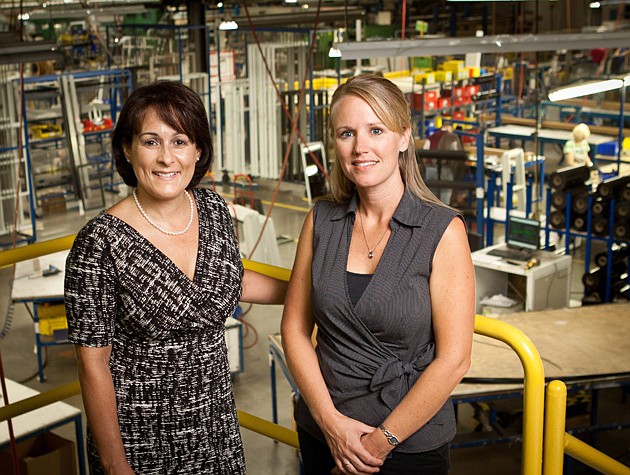When PGT Inc. CEO Rod Hershberger wanted to expand production for the North Venice custom windows and doors manufacturer, he needed skilled workers — and he needed them fast.
With 1,200 current employees, the company, which earned $176 million in 2010 revenues, already had a base of personnel who could be trained for the work. But when it chose to close its North Carolina plant and combine it with its Florida operations, Sarasota County's largest manufacturer needed new skilled labor.
Enter the CareerEdge Funders Collaborative, a nonprofit work force training program based on a flexible national model developed in the Northeast and based in Boston. CareerEdge aims to build career paths for lower income employees by focusing on growth industries and assisting employers looking to fill positions with skilled workers.
Since opening an office in Bradenton in September, CareerEdge has trained 682 employees — including 289 new hires — according to its director, Mireya Eavey. The Sarasota/Manatee program is one of 31 similar ones around the country, but so far the only one in Florida.
Unlike bureaucratic public work force boards that focus on services for the unemployed, CareerEdge contracts directly with targeted employers in high-demand industries including manufacturing, health care, transportation and technology. “They're about serving the employees,” says Eavey, about work force boards. “We're about serving the employers. We're an enhancement.”
CareerEdge, however, does work closely with the Suncoast Workforce Board and staff, says Eavey, who says the two organizations complement one another.
Sally Hill, spokeswoman for the board, agrees. “We absolutely work in partnership,” she says. “There's areas where we may not be able to provide training under the Workforce Investment Act, where CareerEdge can.”
Ted Ehrlichman, the board's COO, says there's no overlap, it's just that CareerEdge is sector-specific. The program also fills a gap, he says. “They're about training for the next better job and the next better job.”
Hershberger likes seeing the training gap being filled at PGT. “I think the program's been wonderful. We take them though an extensive program,” he says about the trainees. “We want them ready to work. Using CareerEdge they're able to do all that training ahead of time. We definitely recommend them.”
That training includes the Florida Ready-To-Work assessment and certification. It also includes “observation testing,” which evaluates workers on the use of equipment they'll be operating in their jobs. At PGT, 195 workers completed the certification and another 85 employees will be going through observation testing soon, Eavey says.
Despite nearly 16,700 unemployed in Sarasota County and a 10.4% unemployment rate as of May, finding skilled workers can still be a challenge for manufacturers and other industries in need of technical know-how or professional expertise. That's a common problem around the country that the National Fund for Workforce Solutions sought to solve when it formed in 2007.
The fund is a collaboration between top foundations and a national network of companies, work force groups and government agencies. Big backers include the Ford Foundation, JP Morgan Chase & Co., Microsoft and the John S. and James L. Knight Foundation.
The national funders provide seed money — $23 million so far — to regional sites to develop localized solutions. CareerEdge's funding includes $1 million from the Knight Foundation, $450,000 from the National Fund, $209,000 from Microsoft (plus a $30,000 software donation), $450,000 from the Gulf Coast Community Foundation of Venice, plus $200,000 from Sarasota County and additional funds from the cities of Sarasota ($120,000) and Bradenton ($400,000 divided among two community redevelopment agencies and the downtown development authority).
In each of the 31 regions where the National Fund is working, regional collaboratives bring together government agencies, foundations and other philanthropic organizations to target financial resources and strategic thinking on creating jobs and careers. Together, the regional collaboratives committed an additional $100 million to the effort.
Mark Pritchett, the Gulf Coast Community Foundation's senior vice president of community investment, says the foundation bumped up its initial $150,000 investment in CareerEdge to target health care worker training.
Blake Hospital in Bradenton has put 239 employees through the training, nearly all for trauma certification, but several also received surgical technician training, says Eavey. “The key is working with employers that know where the jobs are that makes this successful,” Pritchett says. “It's the dollars following the employees to these places that makes them get hired.”
Eavey has raised $1.25 million locally so far, and says the program now has funding totaling nearly $4 million. She expects that should keep CareerEdge running for almost four years.
That suits PGT's Hershberger, who says the CareerEdge program helps his company's bottom line. “Normally the training process to bring someone up to speed can take three to six months,” he says. “It cuts a month off.”
Looking ahead, Hershberger adds, “Yes, as we hire people, we'll use it.”
For more information
Visit the CareerEdge website at: www.careeredgefunders.org
Visit the National Fund for Workforce Solutions website at: http://nfwsolutions.org






